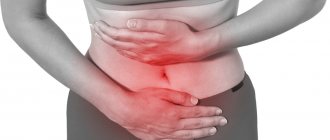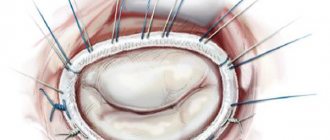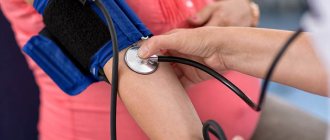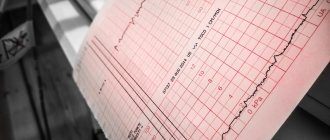Causes
Despite numerous studies, the causes of gestosis remain completely unknown. It is believed that the main reason is the effect on the maternal body of foreign (paternal) components of the fertilized egg. Disturbances in the relationship between the central nervous system and internal organs play an important role in the development of the disease. Women with diseases of the gastrointestinal tract, liver, and asthenovegetative disorders are especially predisposed to the development of early gestosis. Psychogenic factors (negative emotions, fear for the outcome of pregnancy, family conflicts), as well as the undesirability of a real pregnancy or unpreparedness for it, have a significant influence on the appearance of symptoms of early gestosis in pregnant women.
In mild cases of gestosis, the concern is increased sensitivity to odors, nausea, and vomiting no more than 2-3 times a day, often on an empty stomach. In the case when vomiting occurs more than three times a day, appetite decreases, taste and olfactory sensations are disrupted, salivation can be 1 liter per day or more, body weight decreases, then early gestosis during pregnancy requires treatment.
Water is a key element of pregnancy
It is known that the human body is approximately 80 percent water. This means that water is the most important component of our body. During a normal pregnancy, even more water is collected, as much as 6–8 liters, 4–6 of which are outside the body tissues, and 2–3 in the tissues. By the end of pregnancy, about 3 liters of water accumulate in the baby, placenta and amniotic fluid. Another three liters are used to increase the mother’s blood volume, to grow and enlarge the uterus and mammary glands. This is such a flood! Note: this is designed so that there is a lot of water. Whether anyone likes it or not.
The volume of the liquid part of the blood begins to increase very early, from 8 weeks of pregnancy. But, for example, the number of red blood cells is only from 18 weeks. It seems that fluid accumulation is a phenomenon of paramount importance, since the body begins to deal with it so early. And it’s true: after all, how liquid and fluid the blood is, so quickly it can deliver nutrients for the growth of the child, uterus, and mammary glands. And blood can fill a whole new vascular system only if there is a lot of it.
However, the child’s vascular system and all the water space around him is not filled with maternal blood or plasma. Then where does the child get fluid from?
Treatment
Treatment of mild gestosis is carried out on an outpatient basis, at home. For more severe forms, treatment is carried out in a hospital. First of all, non-drug treatment methods are used - physiotherapy, acupuncture, psychotherapy, electrosleep, hypnosis. Drug treatment of gestosis should be comprehensive. Drugs that normalize the function of the central nervous system and suppress the gag reflex are used. Intravenous infusions of saline solutions, glucose, and vitamins are performed. Usually up to 2-2.5 liters of solutions are administered per day. In some cases, medications are prescribed to replace regular meals. When treating pregnant women suffering from early gestosis, it is necessary to monitor biochemical blood parameters and urine tests. In rare cases, with excessive (so-called indomitable) vomiting, which is accompanied by general exhaustion, it is necessary to raise the question of terminating the pregnancy.
Recommendations from experts
Some advice for women who have symptoms of early gestosis:
- Listen to your taste desires, eat only what you want. Food should be easily digestible and contain enough vitamins;
- Eat small meals every 3-4 hours. For nausea, relief comes from chewing (dried fruits, nuts, crackers, salty crackers, lemon, etc.);
- If nausea begins in the morning, after getting up, then you can organize breakfast in bed. In any case, it is recommended to eat something - a piece of white bread or a roll, a cracker, sweet tea. Don’t rush to brush your teeth first thing after getting up!;
- It is recommended to eat dry: food separately, drinks by themselves. In some cases, mixtures and purees for baby food, protein mixtures for pregnant women (femilak, berlamin-modular, enipit) help. Be sure to include alkaline mineral water in your diet. The total amount of liquid drunk can be increased to 2-2.5 liters.
- If you are drooling, it is good to rinse your mouth with an infusion of mint, sage, and chamomile.
Water accumulation and blood loss
Here’s another reason why you should endure the flood that pregnancy brings with it, and not prescribe dehydrating medications and diets: a woman will experience blood loss during childbirth. I'm not even talking about bleeding (although this happens), just normal blood loss, after which you will have to recover.
Now call on common sense to help: which woman will better tolerate blood loss and recover faster: the one who has a lot of blood, or the one who has little? The one that lost thick concentrated blood, or the one that lost diluted blood? Which one will lose more formed elements and nutrients?
A normally well-nourished and not dehydrated woman tolerates even significant blood loss surprisingly easily.
Why is late gestosis dangerous?
Late gestosis (late toxicosis) develops in the second half of pregnancy, after the 20th week and is manifested by edema, increased blood pressure and the appearance of protein in the urine. The reasons for the development of this pregnancy complication are not fully understood. According to one of the modern theories, the development of late gestosis is associated with the production of immune antibodies by the maternal body against the cells of the developing fetus. These antibodies have a damaging effect on the wall of blood vessels (primarily small vessels of the kidneys and placenta). As a result, the lumen of the vessels narrows, the blood flow through them slows down, and microthrombi appear in the bloodstream, which disrupt blood circulation in the vessels that supply blood to vital organs. Spasm of blood vessels and changes in the structure of their walls lead to the appearance of edema, increased blood pressure, and impaired renal and placental function. As a result, placental insufficiency develops, the growth and development of the fetus slows down, and the risk of hypoxia increases. The earlier the symptoms of late gestosis appear, the more severe it is and the more unfavorable the prognosis for both the mother and the fetus.
Two more important substances are salt and protein.
The reader already understands why a lot of water is needed for a normal pregnancy. Now, in order to understand where and how problems with “water supply” can arise, we need to understand something more from physiology. Water to reach the child must be in the blood, in the vessels (and not, say, under the skin, in tissues, body cavities). What holds it in the vessels? There are two substances that pregnant women and obstetricians need to keep in mind: table salt and the protein albumin. If there is a shortage of them, water will leak from the vessels into the tissues, causing EDEMA. Vessels in this situation are like leaky hoses: no matter how much water you pour in, you won’t get the required pressure, and everything around is wet.
Albumin is synthesized by the mother's liver from the amino acids of the food that the mother eats. Therefore, it is important what she eats and how her liver works. Salt – comes from food, can be stored by the kidneys; salt metabolism is also regulated by certain hormones. Remember from physiology that the volume of the liquid part of the blood begins to increase very early, from the eighth week? Now remember what pregnant women crave during the same period: pickles, sauerkraut, herring, salted tomatoes.
How does gestosis occur?
The disease usually begins with swelling of the lower extremities (it is difficult to put on usual shoes), then there is morning stiffness and swelling of the hands (it is difficult to remove a ring from a finger), swelling in the abdomen (a mark from underwear remains) and, finally, puffiness of the face. When measuring blood pressure, attention is drawn to the asymmetry of blood pressure numbers on the left and right arms. If this stage of gestosis is not treated, blood pressure rises, protein appears in the urine, and swelling becomes more noticeable. Pressure above 135/85 mm Hg during pregnancy is elevated; when the diastolic (lower) pressure is 95 mm Hg, persistent spasm of the placental vessels develops and the conditions for fetal development are disrupted, and the diastolic blood pressure is above 110 mm Hg. Not only is it dangerous to the life of the fetus, but it can cause serious complications for the mother.
The peculiarity of late gestosis is that expectant mothers do not worry about anything for a long time in the presence of the disease. They often do not follow doctor's recommendations and are reluctant to go to hospital for treatment. And in vain. If the disease is not treated in the early stages, it progresses to more severe stages - preeclampsia and eclampsia. Against the background of high blood pressure, edema and high protein content in the urine (more than 1 g/l in a single portion of urine), a pregnant woman develops headache, nausea, vomiting, and visual disturbances (“flies flash before the eyes”). These are symptoms of developing cerebral edema. If the woman is not given medical assistance at this stage, her condition will quickly deteriorate and eclampsia will develop. A pregnant woman suddenly develops convulsions and loss of consciousness. Preeclampsia and eclampsia can result in severe complications - cerebral hemorrhage, placental abruption, intrauterine fetal death, retinal detachment, massive bleeding. Treatment of severe forms of late gestosis is carried out only in the maternity hospital. After stabilization of the pregnant woman's condition, it is usually necessary to carry out a gentle delivery.
The placenta is a key character in pregnancy
So, we have come to the most important point in the physiology of pregnancy. From the mother's blood, everything necessary, and first of all water, is obtained by another main character of pregnancy, which is not well known - the child's temporary organ called the placenta.
The placenta begins to form like this. Approximately on the 7th day after conception, after traveling a long way through the fallopian tube, the embryo ends up in the uterus. An embryo is an unborn child in a vesicle, the shell of which is covered with villi. When the vesicle is near the wall of the uterus, it first attaches to it with its villi, and then gets to work: with the villi it rebuilds the vessels of the uterus so that they become dilated, full of blood, and around the villi itself they form a mini-pool of mother’s blood, which is constantly and quickly renewed . In this case, the baby’s blood in the villus and the mother’s blood in the pool do not mix. Much like a germinating seed, its roots absorb water and everything it needs from the soil, but not sand, clay and other large objects. “You provide us with building materials, but we know what and how to build,” both the embryo-child and the seed of the plant seem to be saying.
The seed takes roots from the soil only what it offers it. It cannot cause rain, or turn an underground source towards itself. Not so with the placenta: it is not a simple pump that pumps out what is given. No, she, in the apt expression of Michel Auden, is a “baby’s lawyer,” who, among other things, knows how to intervene in the physiology of the mother’s body and “squeeze” out of it what the baby needs. And if the blood pressure (and it is provided by water) in the placenta and the baby begins to fall, she will do everything to get the necessary fluid.
The placenta grows and develops; its construction also requires nutrients from the mother’s blood, and by 18 weeks its formation is generally completed. That is, by the time the child’s rapid growth begins, there should already be a powerful, functional placenta.
So, let's remember two facts well. First: the amount of water in the mother’s blood determines the amount of water in the child, as well as how well building substances will flow to him. Second: the placenta, as an active organ-advocate of the child, in case of shortage, will manipulate the mother’s body so as to receive enough nutrition and water. Up to conflicts.
Prevention of gestosis
Prevention of late gestosis consists of creating the correct work and rest regime for the pregnant woman. It is necessary to protect the pregnant woman from working on the night shift; when the first signs of the disease appear, she should be released from work altogether and a protective regime should be created, ensuring a calm emotional state for the pregnant woman. Decoctions of soothing herbs (motherwort, valerian), complex herbal preparations - persen, novapassit, sanosan; preparations containing magnesium ions - MagneB6, Magnelis or Magnerot. You should not significantly limit the amount of liquid you drink; it is better to drink green tea, rosehip decoctions and mineral water. For edema, diuretic preparations containing lingonberry leaf, bearberry and others are recommended.
If edema increases, blood pressure increases, or protein appears in the urine, treatment must be carried out in a hospital setting.
Diets of all stripes
Now we should briefly list all the restrictions on food and drink that are now imposed on pregnant women. The most common is what obstetricians-gynecologists still recommend in antenatal clinics: limiting salt (do not add salt) and drinking (two glasses a day) for swelling or rapid weight gain. We will not repeat ourselves; it is explained above why this recommendation should be considered outdated and anti-physiological.
The recommendation is to eat less so as not to “feed” the baby, since it is easier to give birth to a small baby. It is usually given along with advice to drink less so that there is no swelling. This belief contradicts physiology and is fraught with disturbances in water metabolism and nutrition in mother and child. Already in the 1930s, several special diets were proposed to limit a child’s weight gain (for example, Dr. Prokhovnik’s diet with a drinking limit of 300-400 g and others). At the same time, they abandoned the use of such diets, since “their effect is questionable and compliance is difficult.” And, let us add, it is not useful, and for some it is dangerous.
Diet to prevent allergies in a child. Research shows that prescribing an allergen-free diet does not significantly reduce the risk of having a child with allergies. This diet may adversely affect the nutrition of the mother or baby in the womb.
Fast. Religious fasts are not (or should not be) intended to cause exhaustion or illness. If a mother can carefully plan her meals so that she gets everything she needs from fasting food, then let her fast. In practice, we, obstetricians, often see a large family with a mother who gives birth and feeds continuously, and they all eat sandwiches and cereals, cookies, bread and sweets. Unfortunately, eating disorders in religious families are the rule rather than the exception. It is not surprising that pregnancy and childbirth are sometimes difficult, and postpartum recovery is long.
Laman diet. This new Moscow trend is a type of dry eating. The diet consists of not drinking water, but only bound liquid (that found in vegetables and fruits, juices and other foods). To put it bluntly, it is to make it difficult for the body to access water. It should be noted here that the German naturopathic doctor Heinrich Laman, who lived and worked in the late 19th and early 20th centuries, introduced 5 different diets for patients with various diseases. I could not find any evidence that he recommended his diets for pregnant women. Most likely, given the great popularity of this doctor, Russian doctors recommended the Laman diet with dry eating to edematous pregnant women on the principle of “what if it helps?” The swelling, of course, decreased. The possible consequences of such dehydration were mentioned above. At the beginning of the twentieth century, doctors did not know enough about the physiology of pregnancy, where edema comes from and how it is related to gestosis. And we know. Therefore, prescribing the Laman diet for pregnant women seems anti-physiological to us, and dangerous for the unhealthy and poorly nourished.
Self-adherence to a diet with the goal of “not gaining weight, not getting fat.” The goal is good. But the product should only be such that the mother and child are fully provided with proteins, healthy fats and carbohydrates. In order not to gain weight, you need to limit refined sugar, white flour products, store-bought baked sweets, animal fats and eliminate trans-isomers of fatty acids. And choose foods with a low glycemic index. And move for at least an hour every day. That's all. You need to eat well and enough. After all, we want a healthy mother and child, and not a wasp waist immediately after childbirth?
Use of diuretics. Diuretic drugs for edema are now rarely prescribed to pregnant women and only by obstetricians who are completely unaware of modern scientific data. But the use of “diuretic herbs” is widespread and widespread. They use bearberry and lingonberry leaf. This is perhaps less dangerous than pills, but in this case it is completely “wrong”.








